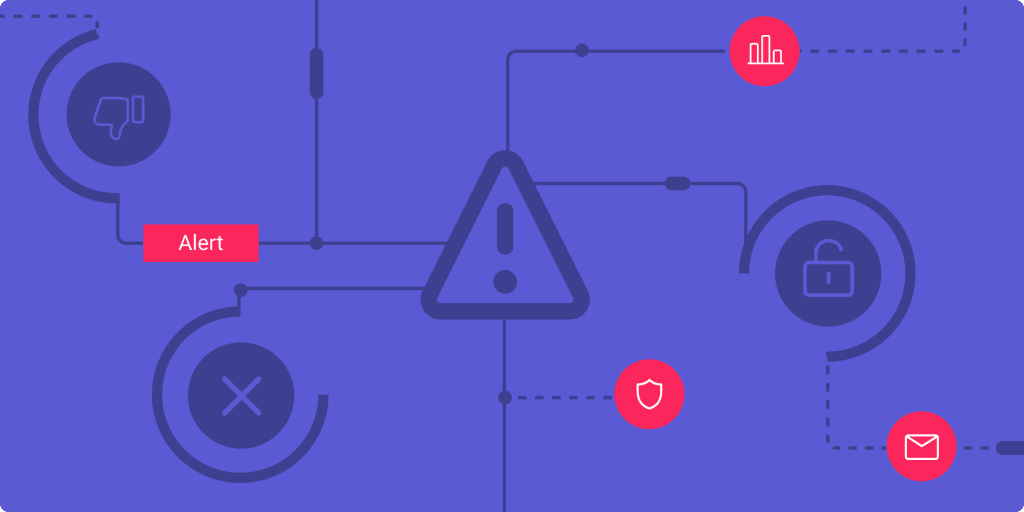Risk management is your first line of defense against failed projects. Unexpected issues like missed deadlines or cyber threats can quickly derail your progress if you’re not prepared.
But before you can create a risk mitigation plan, you first need to identify what could go wrong. This is where a risk register comes in to play. This tool helps you log and prioritize potential risks so your team can respond proactively rather than reactively.
Keep reading for a breakdown of how a risk register works, what to include in one, and how tools like monday work management can help you build a risk register that keeps your project on track.
Get the templateWhat is a risk register?
A risk register is a project management tool used to identify, assess, and track potential risks throughout a project’s lifecycle. A risk register helps teams categorize and prioritize risks, so they can be analyzed and addressed before they escalate.
In the risk register itself, there are important details about each risk, such as the likelihood of it occurring, its potential overall impact on a project, and an action plan for how it can be avoided or handled if it does arise. This is especially useful when you want to perform a risk analysis during a project or even after an event occurs.
Risk register vs. risk matrix
Although a risk register and risk matrix are similar, they’re not the same. They’re both a part of a risk management strategy and help teams mitigate risk but with different executions.
- A risk register is a living document that includes the key components we covered above, including descriptions, impact, and prioritization.
- A risk matrix is a visual tool that plots risks by likelihood and severity, making it easy to see which pose the greatest threats at a glance. However, it lacks the detailed context and planning information found in a risk register.
Because they offer different perspectives (one is detailed and strategic and the other visual and comparative) teams often use both tools together for a more comprehensive approach to risk mitigation.
5 common risk scenarios to include in your register
Identifying risks is a foundational part of creating an effective risk register, but knowing where to start can be tricky. To help, here are 5 common project risk scenarios that teams frequently encounter. These can serve as a starting point when you begin logging risks in your register, giving you a framework for spotting similar threats early.
- Cybersecurity threats: Data can get stolen or systems can be breached, which not only is a liability issue, but can redirect essential resources away from a project.
- Scope creep: New tasks are added to a project without the right approvals, leading to the scope expanding beyond the team’s control and impacting budgets and resources.
- Communication issues: Communication breaks down between teams, individuals, stakeholders, or managers, leading to delayed deliverables and misunderstandings.
- Scheduling risk: A project risks not being delivered according to schedule if tasks aren’t correctly planned for, estimated, and resources are miscalculated.
- Technology problems: If there’s an issue with the technology used to complete a project, like incompatible hardware or faulty integrations, it can lead to stalled progress and delays.
Every project is unique, and these scenarios highlight just how varied risks can be — from technical glitches to shifting timelines or stakeholder concerns. That’s why it’s important to build your risk register early and revisit it often. Let’s walk through when to create one and how to make sure it evolves with your project.
Pro tip: want to have AI identify and analyze all your risks? Check out our new features in our guide to AI-powered risk management.
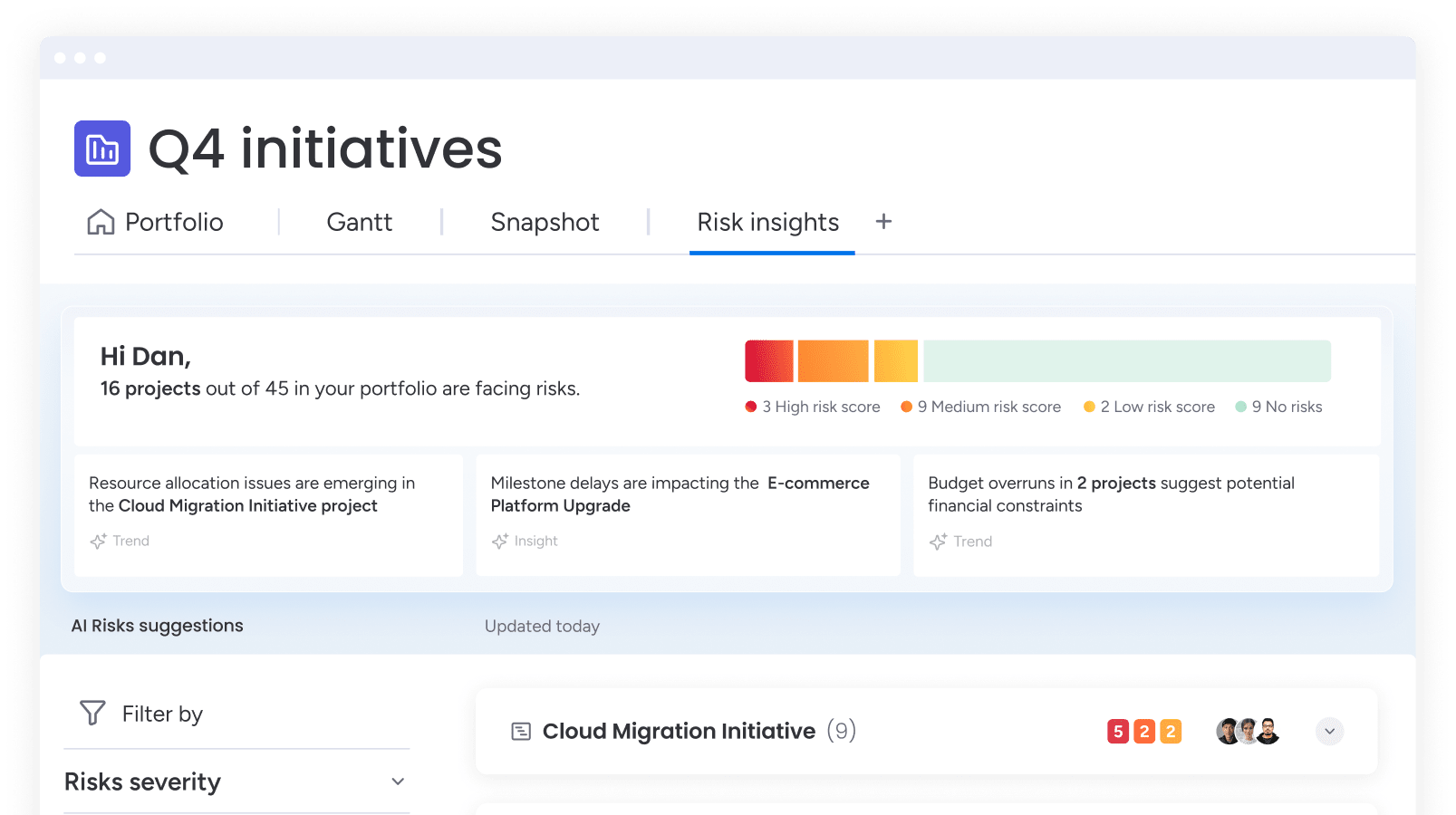
How and when to use a risk register
If you begin building your risk register when problems start to come up, you’re too late and you risk derailing project progress. Statistics show that roughly one-third of project managers don’t engage in risk management, leaving their projects susceptible to major delays or even failure. Ideally, risk registers should be created at the beginning of every project lifecycle, no matter how big or small the project.
By nature, your risk register will serve different purposes as you move through the various stages of your project. Here are some examples of when risk registers should be used:
At the start of a project
This is when you want to get ahead of potential issues that can come up down the line, even if they’re projected to be months away. Preparing in advance is the best way to avoid potential roadblocks and create a proactive plan of action.
The project planning phase
In the project planning phase, you’ll go through tons of different facets of your project, including resources, timelines, objectives, team members, and much more. While creating your project roadmap, you should include time to assess risks and incorporate risk register management into your overarching project plan.
Project changes or developments
If, for any reason, your project changes scope or takes a different direction, you should go back to your risk register and see if new potential risks have come up. Even a small change in a project’s goals or scope can open the door to future risks over time, so it’s a good idea to always be prepared to reassess your risk register and keep it current.
The benefits of using a risk register
Risk management professionals agree that creating a risk register is an extremely valuable project process, yet so many teams and project managers don’t give it the time and attention it deserves. To fully understand the ways a risk register can make a difference in project management, let’s take a look at some of its key benefits.
More proactive contingency planning
By identifying the potential project risks, you have the opportunity to create a contingency plan on how you’d deal with them, which can reduce additional consequences and stress. Integrating risks into your project plan with accompanying plans for how to handle them allows your team to stay proactive instead of losing time and focus on reacting to unforeseen risks when they arise. Using a contingency plan template is a great way to plan for risks in advance.
Greater stakeholder reassurance
Making an effort to identify and record risks and their potential mitigation strategies acts as a reassurance to stakeholders that you’re taking risk management seriously. It demonstrates that you’re invested in the success of the project and understand any potential challenges and limitations of your project’s business environment.
Better risk ownership and accountability
When risks are identified and recorded in the project risk register, they’re also assigned a risk owner. By working through the risk management process, there won’t be any scrambling or doubt as to the ownership of each risk. Understanding who is liable for the risk impact on the overall project outcome is ideal, as you’ll know who to turn to first if a problem arises for quick resolution.
Improved decision making
Once you have all your risks laid out and prioritized, it becomes easier to make tough decisions quickly throughout a project. This way, your team can focus more on those risks that are truly more important while spending less time and resources on those deemed less likely to occur. When it comes time to make decisions, you can let your risk register guide you by assessing which decision is likely to have the lowest risk factor.
What's included in a risk register
There are a lot of different elements that get factored into a risk register. It’s not enough just to add a risk to a list and forget about it; to really make the most of a register, you need to ensure you’ve collected the right details and are actively referring to your risk register for updates and information. Here’s a quick overview of the essential components in a risk register:
- Risk identification: First, start by identifying the risk by name, number, the date you found it, and a brief summary of what it is
- Risk description: After the risk is ID’d, you should add an overview of the risk and its potential impact so that others looking at it can assess its priority level
- Risk categorization: Add a category to the new risk, whether it’ll affect the project operationally, the budget, resources, timeline, technically, or if it’s a security risk
- Risk ownership: Note who owns the risk, in other words, make sure someone is accountable for it so they’re the authority and someone is constantly monitoring it
- Risk analysis: Get multiple team members to analyze the potential impact the risk can have on your project based on how it will affect overall goals
- Risk likelihood: Next, assess the likelihood of a risk occurring to make it easier to sort and prioritize
- Risk priority: After determining impact and likelihood, assign a priority level to your risk to make it easier to track the most important or potentially catastrophic ones
- Risk mitigation: Once you’ve defined multiple angles of a risk, create a plan to mitigate it if it does happen so that you’re ready to take action as soon as it happens
- Risk status: Keep track of your risks on an ongoing basis with status updates, such as if it’s active, mitigated, or closed
There’s a lot to keep track of in a risk register, which is why it’s ideal to use a risk register template that’s ready to use so that you can plug in your data and quickly start risk tracking. Platforms like monday work management have risk register templates that are easily customizable and can even help notify you of risk status updates.
Get the templateHow to create a risk register in 6 key steps
Building your own risk register can take time. Not only is building it a process, but it’s also essential to train your team on how to use and update it regularly so that it fulfills its function. Of course, to speed things up, you can always use a risk register template and customize it to your liking. Below, we’ll go over the 6 steps you should follow to create your own risk register.
1. Identify risks
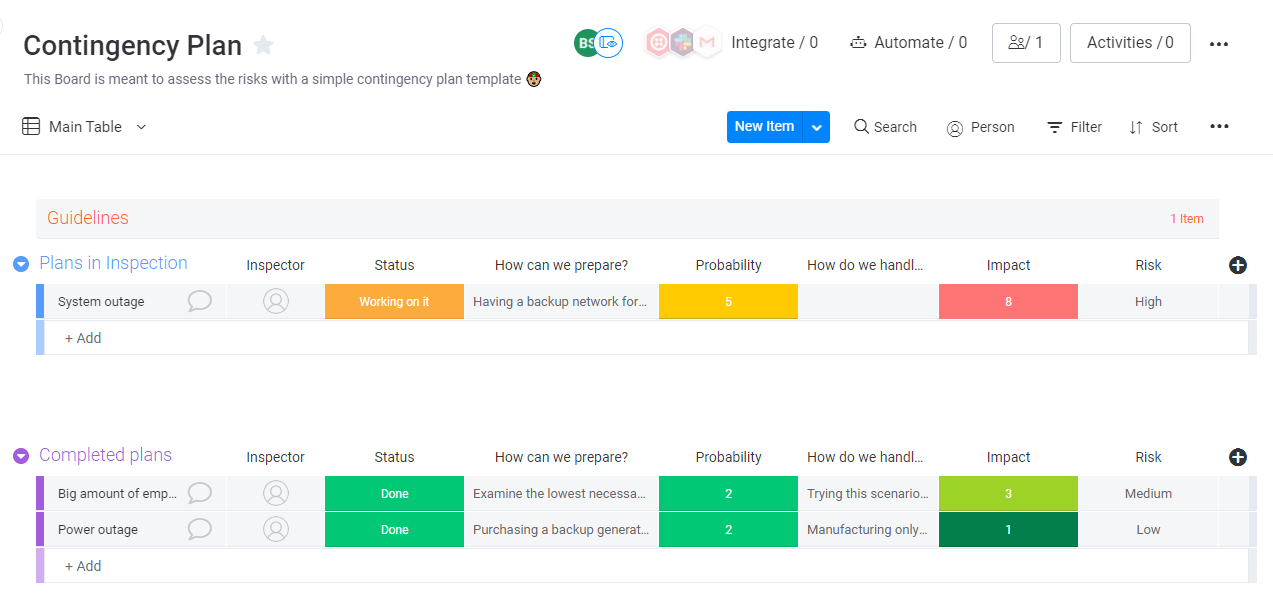
The first step is to identify potential risks to the project. Much of this information will be sourced from other project documentation, such as the cost management plan, resource planning, project schedule, stakeholder analysis documents, etc.
It’s also a good idea to gather more information through various business procedures, like conducting a SWOT (strengths, weaknesses, opportunities, threats) analysis , interviews, brainstorming sessions, or reviewing historical data from previous projects to understand where problems came up. Each identified risk can be added to a risk register template to form the basis of a risk management plan.
2. Define risks
Next, you’ll want to create a definition of each risk, adding crucial information like how it was identified, what makes it potentially dangerous to your project, and how exactly it could affect your work. You can also create a risk breakdown structure here to help you identify different causes of risks in a project. At this point, it’s also important to make sure that all stakeholders have a good understanding of the high-priority risks so that they’re aware of what to look out for.
3. Analyze risks
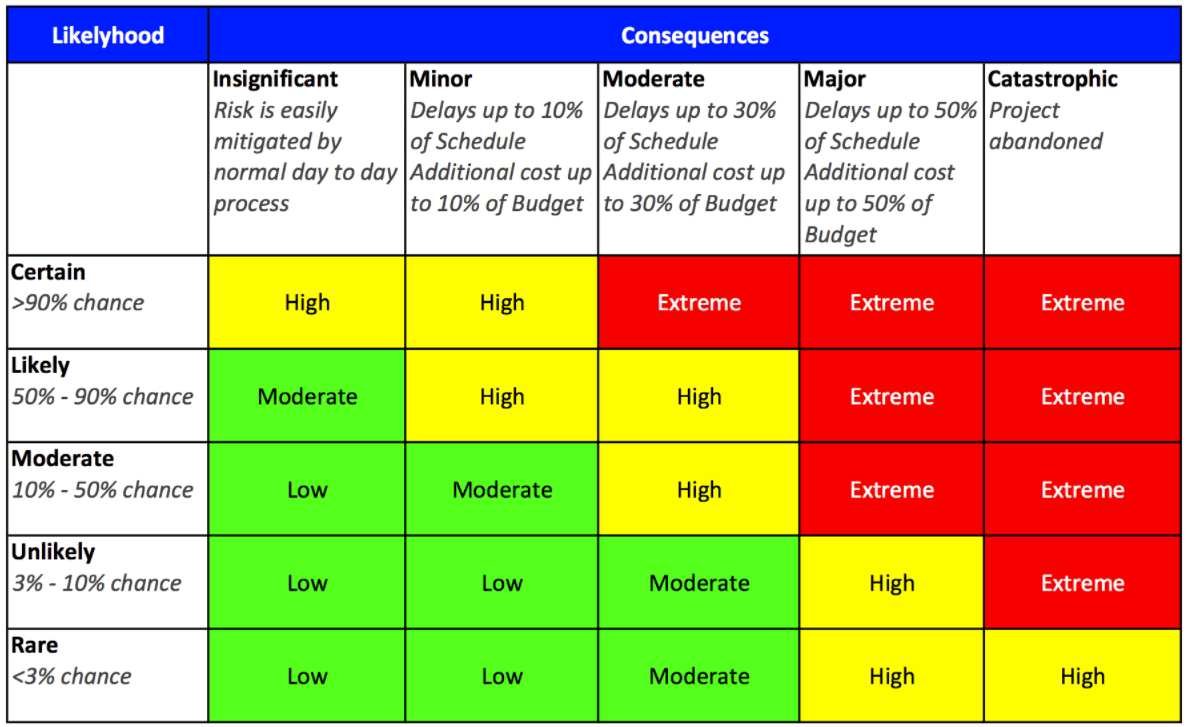
(Source)
The process of analyzing risks should be done in conjunction with business stakeholders. Each individual risk will need to be given a rating according to:
- The likelihood of it happening (risk probability)
- How much of a problem would it be if it happened (risk impact)
Project managers can then complete a risk assessment and create a risk matrix to define the level of risk. Once this information has been assigned to each risk description in the risk register, project managers can prioritize those that need to be most carefully monitored and controlled.
4. Create a risk response plan
Once risks have been analyzed and prioritized, team members can create strategies and risk response activities for dealing with risks that are a threat to the overall project’s success. While we normally see risk as a negative thing, this is also the time to plan out responses to any positive risks or opportunities that have been identified.
5. Assign ownership
With risks prioritized and response plans ready, it’s time to assign each risk to a team member. The risk owner is the person responsible for ongoing monitoring of the risk so that they can notify the team if something has changed, such as its status, likelihood, or impact. This step is essential to ensure accountability and make sure each threat is closely followed to maximize mitigation.
6. Monitor and update
The risk register should be actively managed throughout the project lifecycle. Existing risks can be tracked and their statuses can be upgraded or downgraded as the probability of a risk event and impact changes. If a new risk is identified during project execution, it can be added to the risk log along with a mitigation strategy.
Statistical models, such as S-curves, can help track actual project performance against what was expected and highlight any growing risks in key variables such as project cost and availability of resources. This becomes especially crucial for enterprise risk management, where there are more moving pieces, stakeholders, and involved teams.
See it in action: A real-world risk register example
To better illustrate how a detailed risk register might look, here’s an example of a risk register entry based on a common project scenario: a supplier delay.
| Risk identification | ID: R-003 Name: Supplier delay Date Identified: April 15, 2025 Summary: The key supplier is at risk of not meeting delivery deadlines due to labor shortages. |
| Risk description | If the supplier fails to deliver critical components on time, the project timeline could be delayed by 3-4 weeks and affect the final delivery, leading our team to potentially incur penalties. |
| Risk category | Timeline/resources |
| Risk ownership | Sarah Johnson, Supply Chain Manager |
| Risk analysis | The team consensus is that there would be a high impact on production schedules and downstream processes if supplies are delayed by more than 10 days. |
| Risk likelihood | Medium, estimated at around 50% probability |
| Risk priority | High |
| Risk mitigation | Identify alternate suppliers, expedite partial shipments, and buffer timelines in downstream tasks to absorb a potential delay. |
| Risk status | Active |
Manage risk more effectively with monday work management
The key benefits of working within an integrated platform like monday work management are visibility and ease of collaboration and communication. These factors are important in risk management, as ownership may be spread across the project team and business areas and help you create a more effective risk register.
Collaborating on risk management is easier when everyone’s on the same page. Supporting the multiple stakeholders who are often responsible for monitoring and mitigation, monday work management helps streamline communication by reducing email overload, consolidating tools, and integrating with your existing workflows.
Here’s a closer look at the key features that make monday work management a risk management software to manage your risk register.
Start tracking risks right away with templates
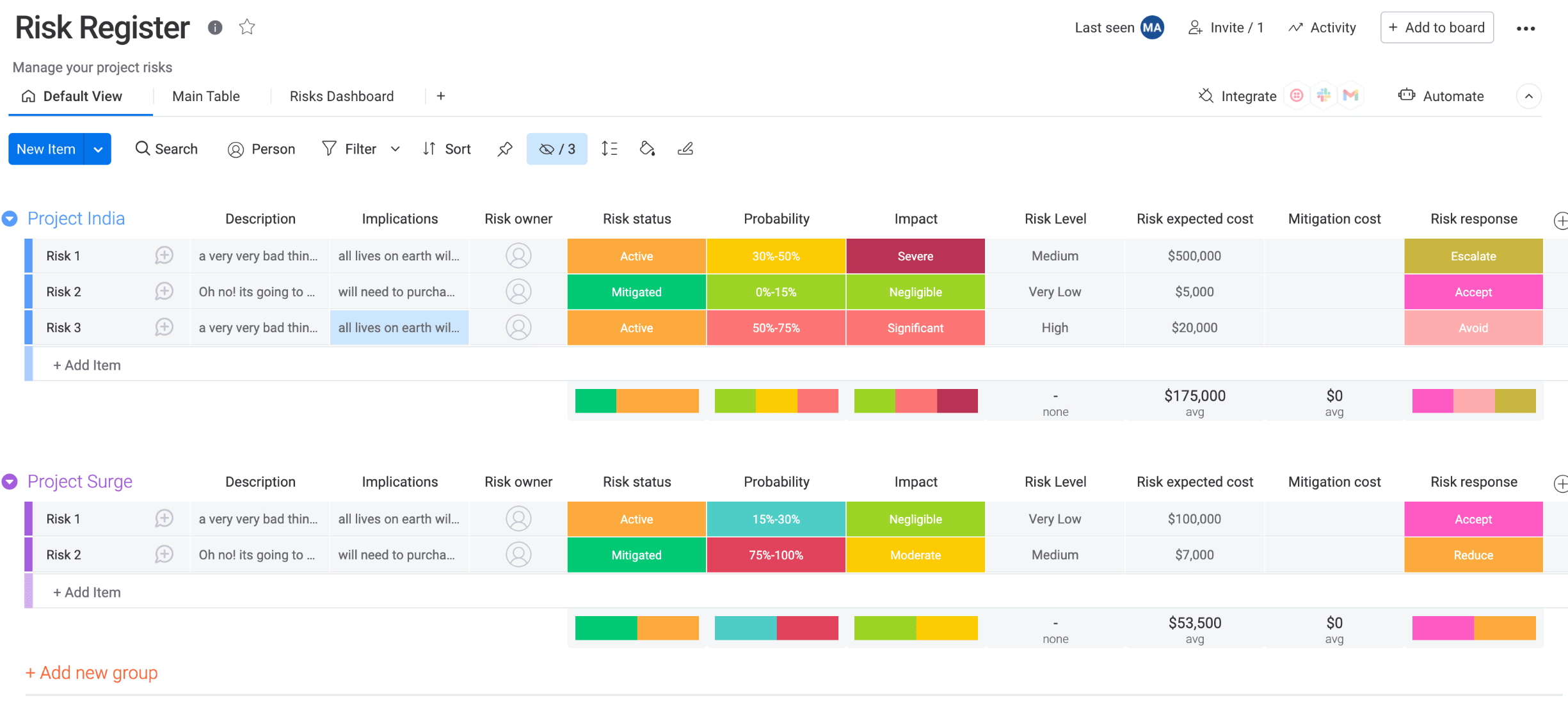
Get started on the right foot with ready-to-go templates for risk management and a risk register with monday work management. The templates are entirely customizable to any unique requirement, so you can start with something premade and then add columns for added details, risk statuses, linked documents, and more.
Automate risk follow-up
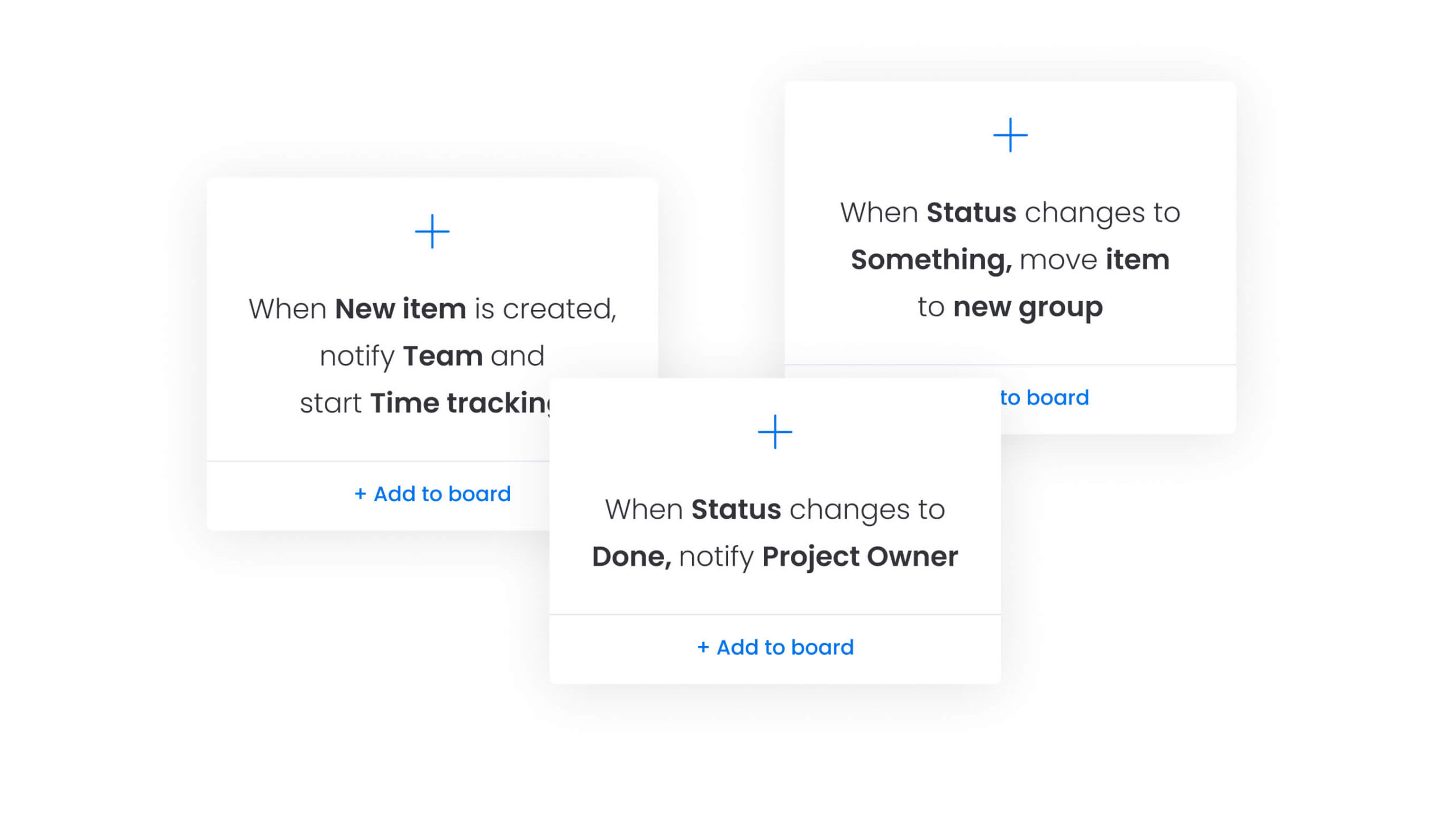
As a smart platform, monday work management uses AI and automations to make work more efficient. Create no-code automations to get notified as soon as a risk status changes, instant reminders to follow up on specific risks, and put your manual risk management tasks on autopilot.
Real-time reports to get deep risk insights
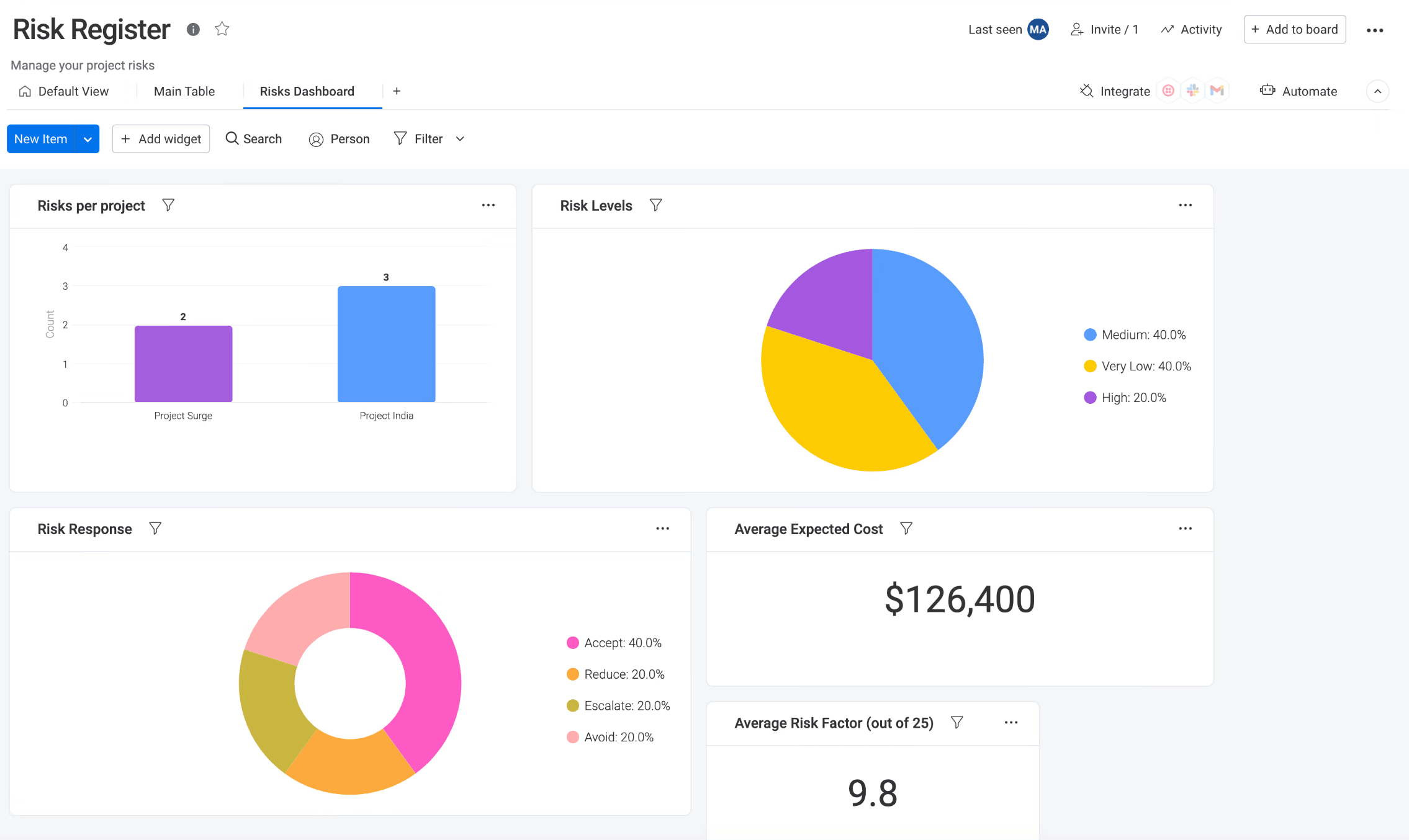
Equipped with real-time reporting, monday work management gives you detailed insights into your risk register and risk management plan. You can view updated dashboards to get a quick overview of current project risks or drill down into small details of each project with reports to make smarter risk mitigation plans for future projects.
Manage risk for better business outcomes
Proactively identifying and managing your risk doesn’t stop bad things from happening to good projects, but it ensures you have a plan in place if your risks turn into issues. By using a platform like monday work management that helps you plan and manage projects while tracking risks, you can stay on top of threats before they happen and work collaboratively to prevent and take action the second a risk event occurs.
Get startedFAQs
What are the requirements for a risk register?
There are no hard-and-fast requirements for a risk register, as they can be personalized to fit your team’s needs, but most of the time, a risk register should include certain key information. For example, each identified risk should have information such as a unique ID, name, description, category, owner, likelihood, impact, priority, mitigation plan, and current status. It should be regularly updated and accessible to all relevant stakeholders to ensure risks are continuously monitored and managed.
What is the difference between a risk register and a risk assessment?
A risk register is a tool used to document and track risks throughout the life of a project. A risk assessment, on the other hand, is the process of identifying, analyzing, and evaluating risks before they’re formally recorded in the register.
What is a quantitative risk analysis?
Quantitative risk analysis uses numerical data and statistical methods to evaluate the probability and impact of risks, often resulting in measurable outcomes like cost or time estimates. This type of analysis provides more objective, data-driven insights compared to qualitative methods.
- Tags:
- Project risk management
Don’t miss more quality content!
